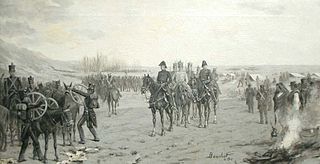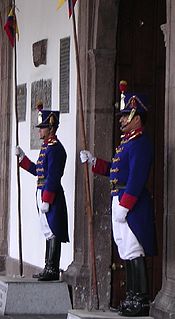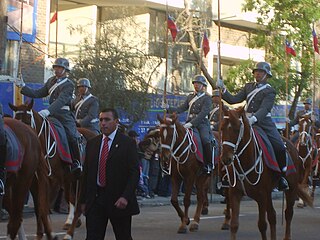
A grenadier was originally a specialized soldier, first established as a distinct role in the mid-to-late 17th century, for the throwing of grenades and sometimes assault operations. At that time grenadiers were chosen from the strongest and largest soldiers. By the 18th century, dedicated grenade throwing of this sort was no longer relevant, but grenadiers were still chosen for being the most physically powerful soldiers and would lead assaults in the field of battle. Grenadiers would also often lead the storming of fortification breaches in siege warfare, although this role was more usually fulfilled by all-arm units of volunteers called forlorn hopes, and might also be fulfilled by sappers or pioneers.

A hussar was a member of a class of light cavalry, originating in Central Europe during the 15th and 16th centuries. The title and distinctive dress of these horsemen were subsequently widely adopted by light cavalry regiments in European armies in the late 17th and early 18th centuries.

José Francisco de San Martín y Matorras, known simply as José de San Martín or El Libertador of Argentina, Chile and Peru, was an Argentine general and the prime leader of the southern and central parts of South America's successful struggle for independence from the Spanish Empire who served as the Protector of Peru. Born in Yapeyú, Corrientes, in modern-day Argentina, he left the Viceroyalty of the Río de la Plata at the early age of seven to study in Málaga, Spain.

The Argentine War of Independence was fought from 1810 to 1818 by Argentine patriotic forces under Manuel Belgrano, Juan José Castelli and José de San Martín against royalist forces loyal to the Spanish crown. On July 9, 1816, an assembly met in San Miguel de Tucumán, declared full independence with provisions for a national constitution.

The Battle of Maipú was a battle fought near Santiago, Chile on April 5, 1818 between South American rebels and Spanish royalists, during the Chilean War of Independence. The Patriot rebels led by Argentine general José de San Martín effectively destroyed the Spanish forces commanded by General Mariano Osorio, and completed the independence of the core area of Chile from Spanish domination.

Juan Esteban Pedernera was interim President of Argentina during a brief period in 1861.

The Battle of San Lorenzo was fought on 3 February 1813 in San Lorenzo, Argentina, then part of the United Provinces of the Río de la Plata. A Spanish royalist force under the command of Antonio Zabala was defeated by the Regiment of Mounted Grenadiers, under the command of José de San Martín. This battle was the baptism of fire for this military unit, and for San Martín in the Spanish American wars of independence.
Juan Bautista Cabral was an Argentine soldier of the Regiment of Mounted Grenadiers who died in the Battle of San Lorenzo, while he was aiding then Colonel Don José de San Martín, whose horse had fallen to enemy fire. The action of Cabral in this first military confrontation of the Argentine War of Independence gave him lasting fame and a prominent place among Argentine patriots.

The Army of the Andes was a military force created by the United Provinces of the Río de la Plata (Argentina) and mustered by general José de San Martín in his campaign to free Chile from the Spanish Empire. In 1817, it crossed the Andes Mountains from the Argentine province of Cuyo, and succeeded in its objective by dislodging the Spanish from the country.

Grand Marshal Juan Gregorio de Las Heras was an Argentine soldier who took part in the Spanish American wars of independence and was also a governor of the province of Buenos Aires.

The Battle of Tucumán was a battle fought on 24 and 25 September 1812 near the Argentine city of San Miguel de Tucumán, during the Argentine War of Independence. The Army of the North, commanded by General Manuel Belgrano, defeated the royalist troops commanded by General Pío de Tristán, who had a two-to-one advantage in numbers, halting the royalist advance on Argentina's northwest. Together with the Battle of Salta, on 20 February 1813, the victory at Tucumán allowed the Argentine troops to reaffirm the borders under their control.

The Army of the North, contemporaneously called Army of Peru, was one of the armies deployed by the United Provinces of the Río de la Plata in the Spanish American wars of independence. Its objective was freeing the Argentine Northwest and the Upper Peru from the royalist troops of the Spanish Empire. It was headed by Hipólito Vieytes (1810), Juan José Castelli (1810–1811), Juan Martín de Pueyrredón (1811–1812), Manuel Belgrano (1812–1814), José de San Martín (1814), José Rondeau (1814–1816), Manuel Belgrano (1816–1819) and Francisco Fernández de la Cruz (1819-1820).

Nicolás Rodriguez Peña was an Argentine politician. Born in Buenos Aires in April 1775, he worked in commerce which allowed him to amass a considerable fortune. Among his several successful businesses, he had a soap factory partnership with Hipólito Vieytes, which was a center of conspirators during the revolution against Spanish rule. In 1805 he was a member of the "Independence Lodge", a masonic lodge, along with other prominent revolutionary patriots such as Juan José Castelli and Manuel Belgrano. This group used to meet in his ranch, then situated in what today is Rodriguez Peña square in Buenos Aires.

The Battle of Tarqui, also known as the Battle of Portete de Tarqui, took place on 27 February 1829 at Portete de Tarqui, near Cuenca, Ecuador. It was fought between troops from Gran Colombia, commanded by Antonio José de Sucre, and Peruvian troops under José de La Mar.

Ángel Pacheco, was an Argentine military officer trained by José de San Martín who later became one of the top commanders in the Confederacy during the dictatorship of Juan Manuel de Rosas. He never lost a battle under his command.

John Thomond O'Brien (1786–1861), also known in Spanish as Juan Thomond O'Brien, was an Argentine Army officer born in 1786 in Baltinglass, Co. Wicklow, son of Martin O'Brien and Honoria O'Connor. He fought in the Chilean War of Independence.
Mariano Necochea was an Argentine-Peruvian soldier.

For more than a century the Military Parade of Chile or Great Military Parade of Chile has been a tradition within the Independence Day holidays in Chile. It is held in Santiago, Chile's O'Higgins Park on September 19 yearly in honor of the Glories of the Chilean Army with a military parade involving not just the ground forces but by the rest of the Chilean Armed Forces: the Chilean Navy, the Chilean Air Force, and the Carabineros de Chile. It is also in honor of the anniversary of the formal inauguration on that day in 1810 of the First Government Junta, which witnessed the first military parade of the independent nation at the Plaza de Armas, Santiago. It is the final act of the national independence celebrations, which are broadcast through TV and the Internet and radio.

The Presidential Escort Group "Granaderos de Tarqui is the President of Ecuador's honour guard service regiment, which protects the Carondelet Palace in Quito. Granaderos de Tarqui, means Tarqui Grenadiers in Spanish.

The 1st Cavalry Regiment "Grenadiers" is the senior cavalry regiment of the Chilean Army, which serves as the Horse Guards unit providing the ceremonial escort in parades and ceremonies to the President of Chile, the Supreme Commander of the Chilean Armed Forces. It provides the guard during flag raising ceremonies monthly in Santiago, the national capital. Together with the 3rd Cavalry Regiment "Hussars" it forms the remaining mounted components of the army in active service.






















